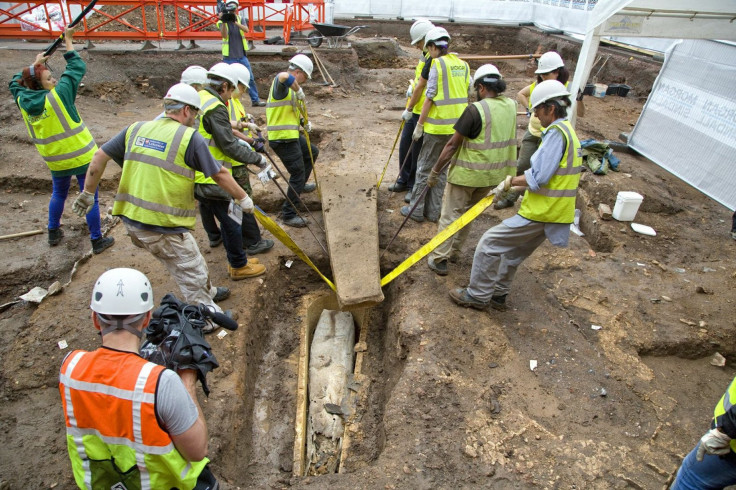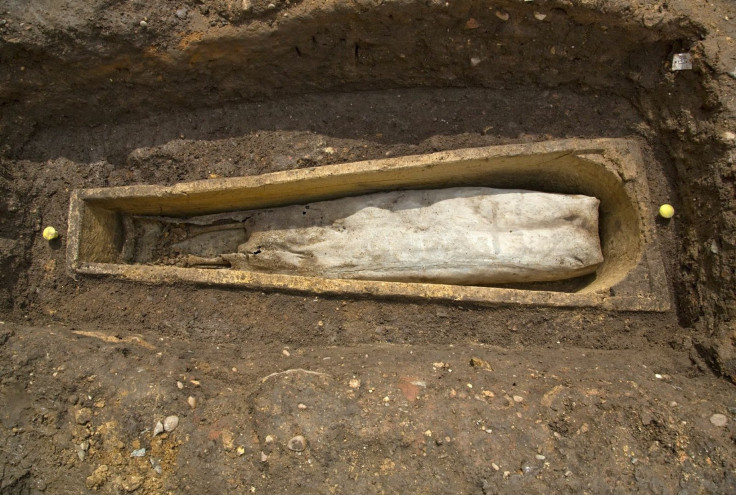Sealed Coffin Found At Richard III Grave In Leicester, Lead Tomb May Belong To English Grey Friars [PHOTOS]


British archaeologists uncovered a mysterious set of ruins beneath the same parking lot where the remains of King Richard III were found last year.
A coffin within a coffin, also known as an inner coffin, was found by a team of archaeologists from the University of Leicester, England, last week. The stone coffin, which is the first fully intact one found in the area, may belong to one of three leaders from the English Grey Friars order, according to a statement.
The inner lead coffin has yet to be opened. It has been sent for tests to determine the best way to open the coffin without damaging the remains within.
"None of us in the team have ever seen a lead coffin within a stone coffin before,” Grey Friars site director Mathew Morris, of the University of Leicester Archaeological Services, said in a statement. “We will now need to work out how to open it safely, as we don't want to damage the contents when we are opening the lid."
A group of eight people removed the stone lid from the outer coffin, which was nearly 7 feet long. Although the inner coffin remains sealed, archaeologists said they could see the buried individual’s feet from a hole at the bottom of the casket.
"It's in remarkably good nick except for one end where we think water trickling down has degraded the lead, so we could just see the feet. They look to be in very good condition, so we hope to learn a lot more from the bones," Morris told the Guardian.
Scientists speculate the remains belong to one of three leaders: Peter Swynsfeld, who died in 1272, William of Nottingham, who died in 1330, or 14th-century knight Sir William de Moton of Peckleton, who died between 1356 and 1362.

The Grey Friars belonged to the Franciscan Order of Catholic monks who established themselves in Leicester in the 12th century. Their friary was dissolved by Henry VIII in 1538 soon after it was demolished. The monks later moved to a mansion 70 years later in Leicester, but that too was destroyed in the mid-18th century.
The remains of King Richard III were found last September under a parking lot in Leicester. University of Leicester archaeologists who uncovered the skeleton confirmed its identity using DNA analysis from one of the king’s remaining relatives, Michael Ibsen, a 55-year-old Canadian carpenter now living in Britain.
“It’s just unbelievable,” Ibsen told Postmedia News after the skeleton was found. “You couldn’t have written a movie script better than this. They find a skeleton with an arrow in its back, a spine with scoliosis and a head wound from a sword. They might as well have found him with a plaque saying HERE I AM.”
Richard III, who ruled England from 1483 to 1485, was the last British monarch to die in battle. He was believed to be killed by Henry Tudor’s army who took over the throne. Archaeologists say Richard III’s body had 10 injuries, including those induced by swords, daggers and halberds. His helmet was knocked off his head, and he was stripped naked and put on the back of a horse. Scars were found on his buttock -- trademark “humiliation injuries” inflicted after he died.
Before his body was found, records say he was buried by the Grey Friars at their church in Leicester, 99 miles north of London. Another theory suggested his remains were exhumed from its grave by a mob and thrown into a nearby river. With the king’s body found, Leicester Cathedral announced plans to put his bones to rest in a tomb that will cost $1.5 million.
"This is an immensely complex project, and we are determined to get it right,” Retired Rev. Tim Stevens, the bishop of Leicester, said in a statement. “Inevitably, that means considerable expense, but we are confident that, with the support of the church and the public, we can honor Richard and his story."
© Copyright IBTimes 2025. All rights reserved.






















